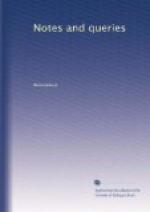Scotch Prisoners at Worcester (Vol. ii., p. 297.).—I cannot think that the extract from the accounts of the churchwardens of St. Margaret’s, Westminster, at all justifies C.F.S. in supposing that the Scotch prisoners were massacred in cold blood. The total number of these prisoners was 10,000. Of the 1,200 who were buried, the greater part most probably died of their wounds; and though this number is large, yet we must bear in mind that in those days the sick and wounded were not tended with the care and attention which are now displayed in such cases. We learn from the Parliamentary History (xx. 58.), that on the 17th Sep. 1651, “the Scots prisoners were brought to London, and marched through the city into Tothill-fields.” The same work (xx. 72.) states that “Most of the common soldiers were sent to the English Plantations; and 1500 of them were granted to the Guiney merchants and sent to work in the Gold mines there.” Large numbers were also employed in draining the great level of the Fens (Wells, History of the Bedford Level, i. 228-244.). Lord Clarendon (book xiii.) says, “Many perished for want of food, and, being enclosed in little room till they were sold to the plantations for slaves, they died of all diseases.”
C.H. COOPER.
Cambridge, Oct. 5. 1850.
Scotch Prisoners at Worcester.—The following is Rapin’s account of the disposition of these prisoners, and even this statement he seems to doubt. (Vol. ii. p. 585.)
“It is pretended, of the Scots were slain [at Worcester] about 2000, and seven or eight thousand taken prisoners, who being sent to London, were sold for slaves to the plantations of the American isles.”—Authorities referred to: Phillips, p. 608., Clarendon, iii. p. 320., Burnet’s Mem. p. 432.
J.C.B.
“Antiquitas Saeculi Juventus Mundi” (Vol. ii., p. 218.).—A learned friend, who although involved in the avocations of an active professional career, delights “inter sylvas Academi quaerere verum,” has favoured me with the following observation on these words:—“That the phrase Antiquitas saeculi juventus mundi is in Italics in Bacon’s work does not, in my opinion, prove it to be a quotation, any more than the words ordine retrogrado in the subsequent passage. Italics were used in Bacon’s time, and long afterwards, to to mark not only quotations, but emphatic words, [Greek: gnomai], and epigrammatic sentences, of which you will every where see instances. I have not the original edition of the work, but we have here[5] the rare translation into English by Gilbert Wats, Oxford, 1640, folio, through which the references to authors are given in the margin; but there is no reference appended to this passage. I cannot of course decide positively that the phrase is not a quotation, but I incline to the opinion that it is not. It may be an adaptation of some proverbial expression; but I prefer believing that it is Bacon’s own mode of expressing that the present times are more ancient (i.e. full of years) than the earliest, and thus to show that the respect we entertain for authority is unfounded.”




